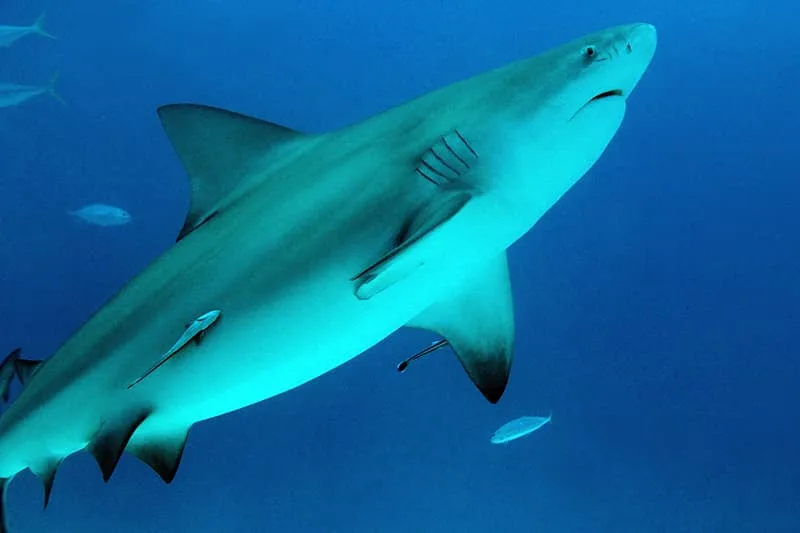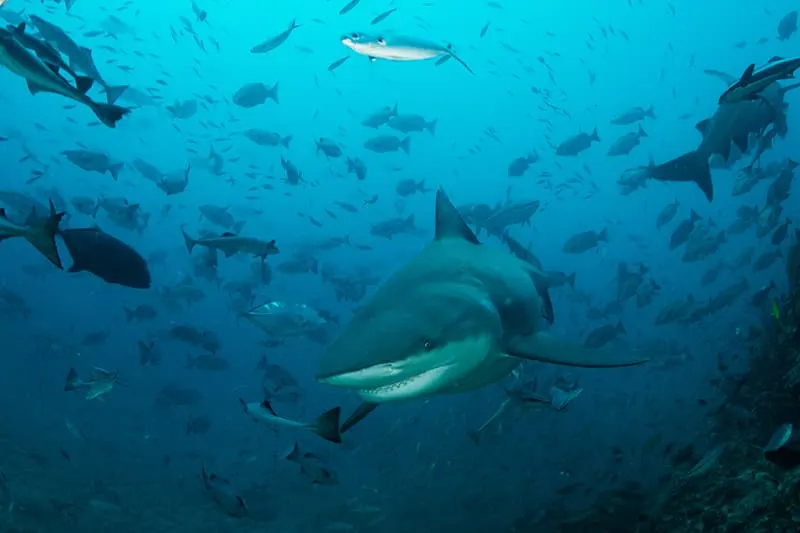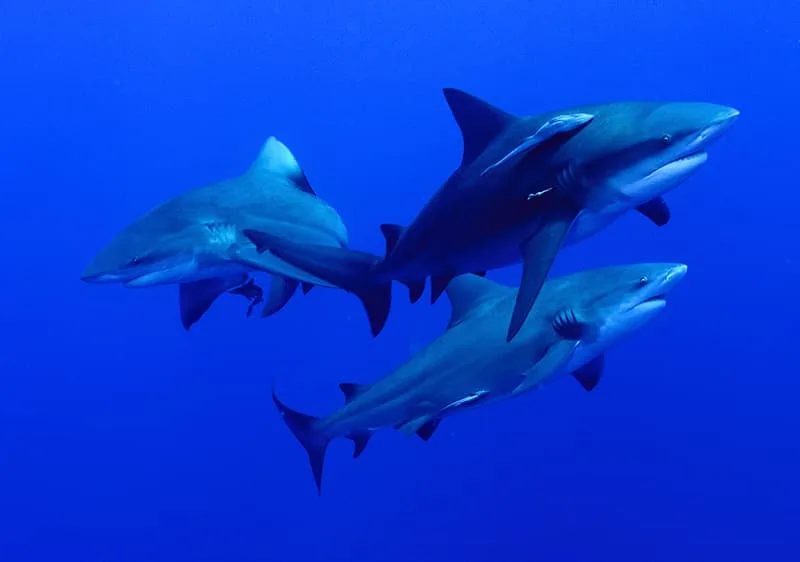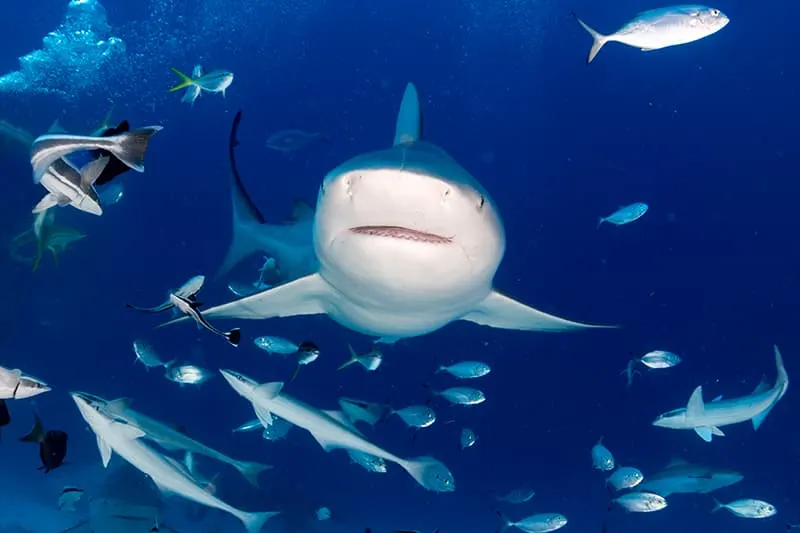Want to learn some bull shark facts for kids? You’ll find them in this post. We’ll talk about their physical description, offspring, special adaptations, and more. Bull sharks are one of the top three sharks that are the most dangerous to humans. Read on to learn more about these fascinating creatures!

Physical Description
The bull shark is a medium-sized shark with a torpedo-shaped body. The width of a bull shark’s body is proportional to its length. This body proportion gives the bull shark a stout appearance instead of a sleek one.
The bull shark has a dark grey back which fades to light grey on its body. The bull shark’s belly is dark white. The bull shark has a rounded snout and two eyes that are smaller in size than most other sharks. The bull shark has hundreds of teeth that are each about one and a half inches long.
The bull shark has seven fins. The triangular-shaped fins located on the bull shark’s back are dorsal fins. The front dorsal fin is bigger and is located near the center of the bull shark's body. The rear dorsal fin is located near the tail. A bull shark has two pectoral fins located on either side of its body.
The bull shark also has two fins located underneath its body. The bigger one is a pelvic fin. The smaller one is the anal fin and is located near the tail. The tail of a bull shark is called a caudal fin and is in a “V” shape.
Bull sharks typically grow to be from seven feet to eleven and a half feet long. They weigh anywhere between two hundred and five hundred pounds. Males are smaller than females.

Habitat
Bull sharks live in the shallow waters of warm regions all over the world. Bull sharks usually prefer shallow coastal waters. They can also be found in any body of freshwater. Bull sharks have been known to migrate up rivers, including the Amazon and Mississippi. Bull sharks prefer to live in water that is less than one hundred feet deep but have been found in waters almost five hundred feet deep.
Habits
The bull shark species is notable for two things. They are noted for their aggression and their ability to live in both fresh and saltwater environments. The glands and kidneys of a bull shark allow it to retain salt when it's in freshwater.
The bull shark species is not the most aggressive shark species. In fact, bull sharks will swim near each other without attacking. White sharks in that same situation are likely to attack each other. Scientists believe that there is a strong possibility that bull sharks may form social bonds with each other. Bull shark bites happen more frequently because people are more likely to be in an area where bull sharks are present.

Diet
Bull sharks are solitary hunters, but they are not picky eaters. Fish, crustaceans, stingrays, and other sharks make up most of a bull shark’s diet. They also devour turtles, seals, and dolphins, among other marine animals. Seabirds are also on their menu.
In captivity, bull sharks are known to change their carnivorous diet to an omnivorous one. Both commercial fish food and frozen food are consumed by bull sharks in captivity.
Offspring
Male bull sharks start mating at about fourteen years old. Females start mating at about eighteen years old. Female bull sharks mate with more than one partner. Bull sharks breed in the warmer summer months. They may breed more often in tropical areas. Bull shark mothers are pregnant for almost a year.
Female bull sharks have “viviparous” reproduction. She keeps the eggs inside of her body until her babies are ready to hatch. During the breeding season, female bull sharks travel to freshwater areas like river mouths to give birth. When the eggs hatch, she gives birth to a litter of baby sharks. Female bull sharks give birth to an average of ten offspring at a time.
A bull shark baby is born tail first. Baby sharks are independent from the time they are born. There are few predators in fresh water, so they have a good chance of survival. Juvenile sharks swim out to the ocean after their bodies have learned how to adjust to saltwater.

Classification/Taxonomy
Kingdom: Animalia
Phylum: Chordata
Class: Chondrichthyes
Order: Carcharhiniforms
Family: Carcharhinidae
Genus: Carcharhinus
Species: Carcharhinus leucas
History
Scientists think sharks have a bony fish ancestor. About 450 million years ago, scientists say that a jawless fish ancestor gave rise to today’s sharks. Since sharks don't have skeletons, there is not much evidence to understand how the bull shark became the amazing predator it is today.
Predators
Adult bull sharks are at the top of their food chain and have few natural predators. Their natural predators are typically other sharks, like the tiger shark. Humans are a bigger threat to bull sharks than natural predators. Commercial fisheries mistakenly catch bull sharks. Bull sharks are often caught in the nets thrown out that are intended to catch other fish species. Bull sharks may also be threatened by habitat loss in their freshwater environments.
The bull shark is listed as vulnerable on the IUCN Red List.

Lifespan
Bull sharks have different average life spans that are dependent upon the region they live in. The average lifespan for a bull shark in the wild is sixteen years. Bull sharks in captivity can live up to thirty years.
25+ Unusual Bull Shark Facts
- The bull shark is named for its short snout, its aggression, and because it headbutts its prey.
- Bull sharks are the only sharks that can live in freshwater environments.
- Due to their tendency to live in shallow water, bull sharks are the third most likely shark to attack humans.
- It's more likely that a person will be struck by lightning than bitten by a shark.
- Bull sharks can eat up to 3% of their body weight each time they feast.
- Female bull sharks give birth every other year.
- Bull sharks can slow down their digestion.
- Bull sharks can usually live in freshwater for about 4 years because they run out of prey.
- The scientific name of a bull shark is Carcharhinus leucas.
- The bull shark is sometimes called “river shark” or “shovelnose shark”.
- About 120 people are bitten by bull sharks worldwide every year.
- Lake Nicaragua, the largest lake in Central America, is famous for its population of bull sharks.
- A bull shark has a stronger bite than a tiger shark or a great white shark.
- Bull sharks are the likely culprits of the New Jersey shark attacks that occurred in 1916.
- Humans can be attacked by bull sharks because the bull shark is curious or hungry.
- Bull sharks have poor eyesight.
- Bull sharks are bigger and bulkier than tiger sharks.
- Bull sharks are about half the size of great white sharks.
- Bull sharks swim 3 times faster than humans, at 25 miles an hour.
- People have a hard time seeing bull sharks because they hunt in shallow, murky water.
- A bull shark has 50 rows of teeth, 3 times more than the average shark.
- People pose a greater threat to bull sharks than bull sharks do to people.
- Crocodiles are known to prey on and eat bull sharks.
- Bull sharks are known for attacking hippos in South Africa.
- A golf course in Australia has a lake infested with bull sharks.
- Sharks were swimming in the oceans before dinosaurs roamed the earth.
- Scientists don't understand why bull sharks developed the ability to adapt to fresh water.
We hope you enjoyed learning all about bull sharks! Did you learn anything new? Let us know any other bull shark facts you know. We’d love to hear from you!
You don't want to miss learning about these cool fish.
